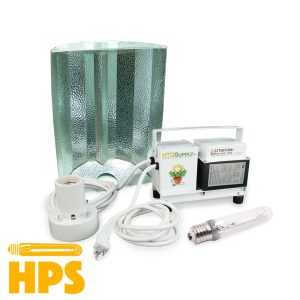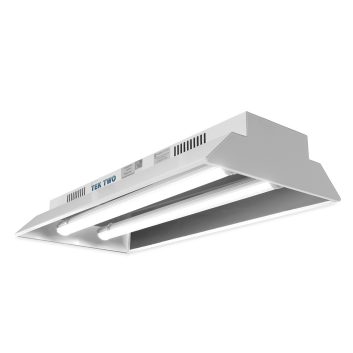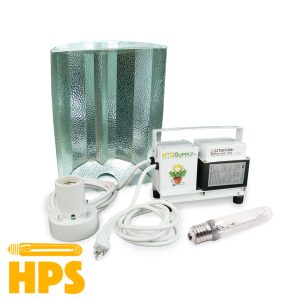HOW TO GROW WITH 100 (AND 11) BUCKS
So you want to hop onto the grow-your-own wagon, but you can’t break the bank in the process. Growing is a rewarding hobby, and the skills you build keeping plants indoors transfer easily to keeping large gardens! This guide will show you an example of a cheap indoor grow setup, making use of the lowest cost items. It’s your first time, so we’re not trying to be America’s next top gardener, what we want is a solid, high-quality harvest. This guide is designed to give you the essentials to a budget grow kit and then some recommendations on how to make the most of a shoestring budget grow. In total, the absolute basic kit will cost about $110. (Keep in mind, these are just the bare necessities, in the second half of this article we’ll discuss recommended upgrades!)
Here is the basic breakdown:
- High-Pressure Sodium Grow Light $78
- Soil $17
- Containers $6
- Nutrients $10
Total Cost $111
Grow Lights
First, let’s look at our grow light options. To keep our costs down, we need to pick an old-school High-Pressure Sodium fixture. The primary factor you need to care for when using HID lighting is heat and temperature control. HPS lights tend to run hot, and having space for hot air to escape will be a huge help in your grow room.
Budget Pick: HTG Supply Budget 150w HPS Grow Light – $78
We picked the HTG Budget 150w HPS Grow Light to power this budget grow. Clocking in at just $78, this is the lowest priced complete light that HTG carries. This will support about 2 plants in a 2’x2′ space. In terms of ongoing power use, we’ll estimate that using 10 cents a kilowatt-hour. This unit consumes 150w, so if we use it at an 18/6 light cycle, we’ll use about 81,000 watts a month, which translates into about $8.10 a month in electrical costs.
2nd Pick: TEK 2 LED Grow Light – $108
If you’re looking to step up the light quality and avoid the heat output of the Budget 150w, the TEK 2 LED uses 80w of power and yields about the same as the budget 150w. The TEK fixture still can grow in about a 2’x2′ footprint and carries all the benefits of LED lighting. This means much lower heat output, longer lamp life, and closer-to-canopy light placement.
Outperformer: HTG Supply 400w Budget HPS Grow Light – $120
If you want the maximum power to price ratio, try the HTG Budget 400w! ($120) This fixture can grow up to 4 plants in a 3’x3′ area and is a major upgrade to this budget setup. For an extra $40 over the 150w kit, this bulb, ballast, and reflector combo has over three times the total light output for vigorous plant growth.
Containers
Next, we need something to pot up your plants. Underneath our pick of a 150w budget HPS, we’ll want a maximum of two plants. That’s easy enough, and the absolute cheapest containers out there for plants are poly grow bags. After that, if we want containers with a bit more growing power, fabric pots are an excellent upgrade from plastic planters.
Budget Pick: 3 Gallon Poly Grow Bags with 11″ Vinyl Saucers – $5.90
Poly Grow Bags are a simple container designed to keep plants with as little cost as possible. Fully collapsible in design, grow bags act just like nursery pots. Bag structure is supported by fluted walls, and punched holes in the bottom let water drain easily.
2nd Pick: 3 Gallon Phat Sacks with 13″ Vinyl Saucers – $8.40
Grow bags are the most basic form of potting containers, if you’re looking for something that’ll last a bit longer and work better for plants, fabric Phat Sacks are your best choice. The fabric walls in place of plastic allow for better soil drainage and air-prune your root tips. Together, this will give your plants an ability to grow faster and resist overwatering.
Outperformer: 3 Gallon Phat Sack Transplanters with 13″ Vinyl Saucers – $10.40
Phat Sack Transplaters are the final boss of fabric grow bags. Thicker fabric walls outlast regular Phat Sacks and provide an excellent balance between root aeration and moisture retention. Notice the overlapped velcro seam, this makes transplanting a breeze, that’s why these containers are called transplanters after all.
Grow Medium
This is where our options are wide open. Most common potting soils are comparable in price, so really it comes down to your personal preference! In terms of brands that meet a budget but also work well, it’s hard to beat Roots Organics.
Budget Pick: Roots Organics Potting Soil – $17
Roots Organics Potting soil is the lowest price-per-cubic foot of all the potting soils we carry, but don’t mistake that for a lack of quality. Blended coco coir, peat moss, and beneficial amendments make up this mix. One bag is $16 and enough to fill two 2 gallon pots.
2nd Pick: Fox Farm Ocean Forest – $21.60
If you’ve looked into indoor growing much at all, you’ve probably heard the name Fox Farm. This company has been putting in the work for over 20 years, creating excellent potting soil mixes with the indoor grower in mind. Ocean Forest pulls together a wide range of soil amendments, with a focus on marine byproducts like fish emulsion, bone meal, and kelp meal, to create a nutrient-dense soil excellent for high yielding indoor plants.
Outperformer: Detroit Nutrient Company Water Only Soil (x2) – $49.90
If you’re looking for a premium alternative, Detroit Nutrient Company’s ‘Great Lakes Water Only Soil’ contains everything you need for a full grow, from seed to finish. While a tad expensive (you’ll need 2 bags of it), using GLWO soil eliminates the need to add nutrients to your soil.
Nutrients
Even more so than potting soils, nutrients have a huge range in both price and manufacturers. For budget nutrients, we are looking for something that’ll last and doesn’t come in too many bottles.
Budget Pick: Happy Frog All Purpose – $10
On a budget, there is nothing wrong with rocking Happy Frog All-Purpose. This is a balanced fertilizer designed for ease of use, and as a bonus, it is OMRI certified for organic use. All-Purpose will work in vegetative and flowering growth.
2nd Pick: Fox Farm Cultivation Nation Veggie and Flower – $25
If we want to step up our game a tad and work with a 2-part nutrient, then Fox Farm Cultivation Nation is your next best bet for a powerful budget option. The separation of grow and bloom fertilizer will provide your plant with concentrated formulas for both the vegetative and flowering cycle of your plants. This will help produce better flowers, as flowering growth will be supported specifically by flowering nutrients. We are sticking with dry nutrients, as they tend to cost less than wet nutrients.
Outperformer: TechnaFlora Recipe for Success Starter Kit – $45
Recipe for Success contains the entire Technaflora line of nutrients in one convenient case. With a 3-part base as well as additives for both veg and bloom, this kit is a powerhouse that is sure to boost your yields. Technaflora was one of the first nutrient companies to release an all-in-one kit, and still today the value price of $45 makes this kit an excellent upgrade on budget nutrients.
Where to Grow
We have all of our supplies, and now we need a location to get set up. Notwithstanding a tent purchase, there are common areas in your house that you can utilize.
- Closet: People have been growing in closets ever since indoor lighting was invented. Just be sure to remove any favorite sweaters or anything you don’t eventually want smelling dank.
- Spare room: A spare room gives you space and the ability to expand your grow. Not everyone just has an extra room to give up, so be sure to consult with your roommate(s) or partner before commandeering the mudroom.
- Bathroom: Bathrooms provide you with direct access to water and a drain, as well as a relatively small room to contain your plant and light. Bathrooms will usually also have ventilation, making an unused bathroom an ideal space to grow.
- Garage: During warmer months, it is perfectly acceptable to grow in your garage. Just be careful about light leaking out under the garage door and the temperature drop in cold months.
- Basement: While a dank, wet basement will probably cause mold on your plants, a dry basement is a great area to keep your garden out of the way. Just be sure that you can influence the humidity of your setup.
- Attic: Just like the basement, an attic with the proper environment can be used to grow. Just be careful about heat issues because well-insulated attics tend to trap hot, dry air.
- DIY grow tent: Using 2x4s and some mylar, you can construct a basic reflective box to contain your plants. This is a cheaper alternative to a grow tent and gives you the ability to build a grow box to custom dimensions.
For any of these areas, buying a mat for the floor to catch any spilled water will be beneficial, especially if your floors are wood, carpet, or other water averse surfaces. Also, keep in mind that if you’re using the HTG Budget 150w HPS, there’ll be some heat output form your lamp. Be sure you can keep the temperature in that space below 80 F.
System Upgrades
Now that we have the basics of our kit, here listed are a few upgrades you can make to help with ventilation, climate control, and smell. Out of everything that you could add to this budget kit, a circulation fan and a thermometer will be the best value. Often, keeping the temperature in check in an indoor garden is one of the most overlooked skills for beginners. Additionally, something like a grow tent will give you peace of mind and a compartment to grow in without taking over an entire room or closet in the house. Or an entire bathroom. You get the point.
- Grow Tent: This is definitely the first upgrade you will want after the kit assembled above. A grow tent gives you the ability to keep all your gardening contained in a single space, isolated from the rest of your space or room. For the budget kit, an AgroMax Small Grow Tent or Grow Shop Outlet 2×3.
- Circulation fan: Air movement in a grow space is crucial for healthy plant growth. It strengthens your plants, protects against mold and mildew, and supplies your plants with fresh CO2. GrowBright manufacturers excellent fans, and a 9″ floor fanwill push enough air to keep this budget grow well circulated.
- Thermometer: Keep track of the temperature and humidity in your garden. A simple thermometer/hygrometer can make all the difference in monitoring your garden’s status.
- Intake/Exhaust fan: For any small grow space using HPS lighting to grow, an exhaust fan may be necessary. Venting air into ducting, out windows, or into another room will keep temperatures regulated while providing fresh air for your plants. If it is too hot in your grow room, usually anywhere above 80F, your plants will suffer, so picking up something like a 6 inch inline duct fan will help exhaust.
- Carbon Filter: If you’re growing particularly smelly plants and need to get rid of the scent, a carbon filter will be your best option. For our budget setup, the GrowBright 4 inch carbon filter combo is an excellent fit. The compact size and powerful air scrubbing carbon will work well to keep a small grow area smelling neutral.
- Reflective Walls: If you’re not in a grow tent and want to push a little bit more light towards your plants, consider using mylar or other reflective films. While an eggshell white wall might reflect about 70% of light, Mylar bounces 95% of light. Use mylar sheetsto line walls or to create a small custom grow tent.
- Rope Ratchets: Adding a set of ratchets to your grow makes it much easier to raise and lower your grow light and other hanging garden items. Think about where you want to grow. Can you hang anything from the ceiling, or perhaps hang hooks in the walls or ceiling to support a grow light? If so, picking up a pair of AgroMax Rope Ratchetswill save a lot of trouble in hanging and adjusting your grow light.
So there you have it, everything you need for your cheap indoor grow setup. An HPS light, some soil, containers, and nutrients are honestly all you need to get started growing. Keep in mind this is the bare necessities to see green, and a few of the recommended upgrades can go a long way to make your life easier. Otherwise, good luck, and happy growing!


